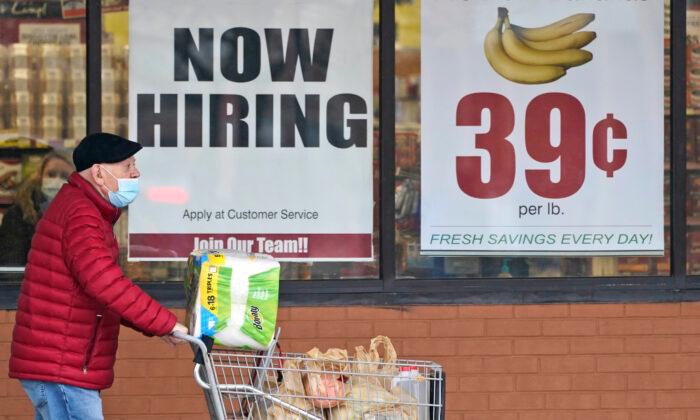The unemployment rate dipped to 3.4 percent, down from 3.5 percent and below the market estimate of 3.6 percent.
Average hourly earnings eased to 4.4 percent year-over-year, down from 4.9 percent in December. This also beat market forecasts of 4.3 percent. On a month-over-month basis, average hourly earnings rose 0.3 percent, down from 0.4 percent. Average weekly hours rose to 34.7.
The labor force participation rate also edged up to 62.4 percent, up from 62.3 percent.
The leisure and hospitality sector led the way, with 128,000 new jobs in January. This was followed by professional and business services (82,000), government (74,000), health care (58,000), and retail (30,000). The construction industry added 25,000 jobs and the transportation and warehousing sector created 23,000 positions. Employment in social assistance increased by 21,000. Payrolls were little changed in mining, wholesale trade, information, and financial activities.
The number of people employed part-time for economic reasons was flat at 4.1 million. The number of people not in the labor force who currently want a job was also little changed at 5.3 million.
There was another divergence between the household and establishment surveys in the BLS report. The household survey showed that there were a little more than 160,000 new jobs last month, up from 159,244 in December. The gap between the household and establishment was about 357,000.
People working two or more jobs stayed roughly the same at above 8 million.
“Despite continued tech layoffs and slower gains in a handful of other sectors, the labor market remains resilient, especially given the rise in the number of job openings to 11 million on the last day of December,” said Cody Harker, the Head of Data and Insights at recruitment marketing firm Bayard Advertising. “Though the market is still showing early signs of shifting, it’s clear that job seekers have leverage in the meantime, particularly in sectors where hiring difficulties or labor shortages remain (retail and food service, for example).”
Financial markets declined following the data, as the leading benchmark indexes were in the red. The U.S. Treasury market was up across the board, with the benchmark 10-year yield up more than 8 basis points to around 3.48 percent.
The U.S. Dollar Index (DXY), a measurement of the greenback against a basket of currencies, spiked on the news, rising 0.5 percent to above 102.00.
Does this mean the recession in 2023 has been canceled?
“This strong result provides support to the hawks in the Fed, who wish to keep hiking as long as the job market is resilient (by comparison, market’s expect the Fed to cut this year),” noted Giuseppe Sette, the president and Co-founder of Toggle AI, an investment research firm. “This result also provides some evidence we could finally avoid a much-feared recession in early 2023.”
A Prelude to NFP Data
Before the BLS release of the January jobs report, a plethora of data highlighted a potential softening of the U.S. labor market to kick off 2023.The most notable finding occurred on Thursday when it was reported that U.S.-based employers announced plans to terminate close to 103,000 workers in January, up from 43,651 in December. This was the highest total since September 2020 and the biggest January print since 2009. The layoffs were driven by technology (41,829), retail (13,000), and real estate (2,191). Companies cited the economic slowdown as a reason for slashing workers and slowing hiring.
However, many market analysts were surprised by the enormous increase in the number of job openings in December, climbing to above 11 million. The openings to unemployed individuals ratio also increased close to an all-time high of 1.9, up from 1.2 before the coronavirus pandemic. The job quit rate was also relatively unchanged.
According to the National Federation of Independent Business (NFIB), 57 percent of employers were hiring or trying to hire. But 91 percent noted that there were few or no qualified applicants for the job openings.
This is becoming “a major concern” for smaller companies in 2023, says NFIB Chief Economist Bill Dunkenberg.
Meanwhile, the NFIB research learned that the percentage of owners expressing labor quality as their chief business operating challenge continues to be elevated at 24 percent. Labor costs are also a persistent problem for employers, with 10 percent calling it their single most important problem they face, which is hovering around the highest readings in nearly five decades.
The report also revealed that the share of finance and technology workers applying for work has tumbled and most professionals in these fields anticipate an income or pay loss in the next four weeks.
In the end, it will be a wait-and-see scenario to determine if the “worst-case scenario comes true,” says Jill Gonzalez, a WalletHub analyst.
“The U.S. economy is expected to grow very little in 2023. This would lead to a jump in unemployment to as high as 4.6 percent, according to the Federal Reserve. Both of these things would be signs of the Fed continuing to try and get a handle on inflation,” she said in a report. “If this ‘worst-case scenario’ comes true, it could mean that millions of people who now have jobs could wind up unemployed.”





